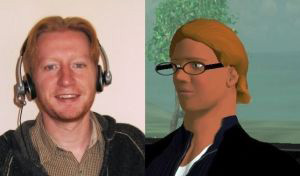 |
 |
 |
 Technology News | August 2007 Technology News | August 2007  
Language Teaching Gains Second Life
 Howard Vickers - PVNN Howard Vickers - PVNN


| | What is an avatar? An avatar is you! You choose exactly what your avatar looks like, what they do and where they go. It's a digital figure you control. It walks and talks within a virtual world such as Second Life. | 
| | You interact with the teacher's avatar in Second Life while speaking with the teacher on Skype, MSN or Yahoo voice chat systems. Lessons include role plays, speaking, listening, reading, writing and doing. Lessons make full use of being in a situation, so the English you learn and practice is exactly what you use in real life. |
La Paz, Bolivia - 3D virtual worlds like Second Life are now being used by language teachers to provide simulation of real life environments and allow students to discover more creative and more realistic ways to improve their language skills.

Language teaching is appearing in Second Life and the online language school “Avatar English” is taking an innovative approach by combining Second Life with voice messengers such as Skype and other online teaching tools. Language educators in Second Life are working together to develop and improve their teaching methods, and an example of this collaboration is the recent SLanguages 2007 virtual conference.

Language teaching in 3D virtual worlds is still at its early stages of development, yet it is generating interest from students, teachers and education consultants. Second Life with over 7 million registered users and $1.7 m of business done daily is rapidly becoming a parallel world for socializing, trading and, learning. The 3D online world is free to access and allows its virtual residents (or avatars) to build their own creations, allowing for an imaginative virtual world.

"Second Life brings immersive, immediate and - more importantly - supportive, social and truly constructivist - potential to distance learning. Combined with a virtual learning environment such as Moodle, this is the killer education application for the inventive teacher" says Gavin Dudeney online-education consultant of The Consultants-E (TheConsultants-E.com) and co-author of "How to Teach English with Technology," Longman, 2007.

Second Life is especially suited to younger learners of foreign languages because they already see the internet as a natural place to learn and play. Marc Prensky (author of Digital Game-Based Learning, McGraw Hill, 2001) refers to this generation as “Digital Natives” because they have grown up within a digital world.

Second Life offers new approaches to language learning and initial feedback from students is very positive. “At first I was so surprised by this virtual school in Second Life. It was a totally new experience for me to learn English like this. Every class was a virtual experience, but at the same time, you get a real improvement in your English” says Bo Jian, student at Avatar English. Teaching in Second Life is more than just the 3D experience. “Technology doesn’t replace the professionalism of an experienced and qualified native speaking teacher, it simply allows us to be more creative” says Howard Vickers, Director of Avatar English.

A growing movement of foreign language educators is exploring the potential of virtual worlds. The SLanguages 2007 symposium on 23 June 2007 brought together language educators to share experiences of teaching languages within Second Life and explore how best to use the virtual world. "SLanguages 2007 served to explore the major issues for language education in Second Life, and guided educators towards best practice" says Gavin Dudeney, whose education consultancy company, The Consultants-E (TheConsultants-E.com), organized the virtual conference.

Although Second Life will introduce an internal voice chat soon, some language teachers have already been using messengers such as Skype to fill this gap. “Languages are all about verbal communication” says Howard Vickers, “so we were very keen to make sure that the students are talking and listening within our 3D virtual classrooms. To do this we use VOIP alongside Second Life”. Tools like Skype have additional advantages by allowing the teacher and student to simultaneously work together on the same document.

For more information on Second Life language teaching or for a free trial lesson, contact Howard Vickers at howard@avatarlanguages.com or visit AvatarEnglish.com

Avatar English is an online language school in the 3D virtual world Second Life. The school offers individual English classes with professionally qualified and experienced native speaking English teachers to students globally. Classes take place in custom built virtual classrooms that reflect the theme of the classes, such as airports, markets, banks and cinemas. Avatar English has recently opened its doors to students around the world and was established by Howard Vickers, an English teacher with international experience, currently based in Bolivia. | 
 | |
 |



